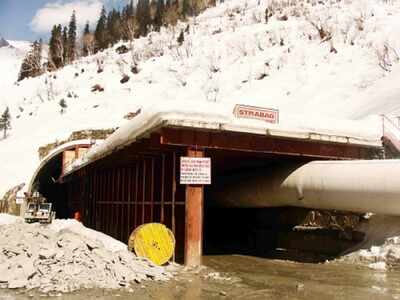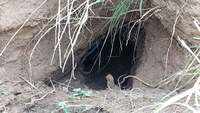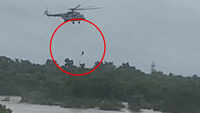
NEW DELHI: The Rohtang Tunnel, the world's longest motorable roadway at an altitude of over 3,000 metres, is ready for opening next month following the completion of civil works that began a decade ago.
The tunnel, also known as Atal Tunnel, will be opened by Prime Minister Narendra Modi by mid-September, Satish Paretkar, director of hydro & underground business unit at Afcons said.
Here is all you need to know about Atal Tunnel:
Why is the tunnel unique in its own way?
* The 9.02 kilometres-long Atal Tunnel, named after former Prime minister Atal Bihari Vajpayee, passes under the Rohtang Pass in the eastern Pir Panjal range on the Leh-Manali highway at an altitude of 3,060 metres at the lowest and 3,078 metres at the peak.
* The tunnel is 10.5 metres wide and has a height of 5.52 metres and a car can zip through at 80 kmph.
* According to Paretkar, the horseshoe shaped single-tube, double-lane tunnel has many firsts. With a length of 9.02 km, it is the longest in the world at an altitude of over 3,000 metres or 10,000 feet mean sea level.
* It is a 10.5-metre wide single tube bi-lane tunnel with a fire-proof emergency egress tunnel built into the main tunnel itself.
Country's first escape tunnel
* It is also the country's first tunnel to have an escape tunnel within the main tunnel because of the topography.
* This would provide an emergency exit in case of any untoward incident, which may render the main tunnel unusable.
* There would be escape tunnels after every 500 meters with a vehicle speed permitted to 80 km/hour and around 3,000 vehicles will be able to run at once on both lanes of the tunnel.
* Globally, escape tunnels are built separately along the main tunnel.
Technology used
* This is also the first tunnel to deploy the Rowa flyer technology, which allows engineers to work at inverted levels, he said.
Paretkar said the delay in completion of the tunnel was mainly due to the 410-metre long Seri Nalla, a brook.
"Seri Nalla was emitting over 125 litres of water per second, making work really hard. In my entire engineering life, this was the toughest job to execute. It took us more than three years to drill 410 metres along the Nalla," he said.
Tunnel features
* The tunnel provides telephone facility at every 150 metres, fire hydrant at every 60 metres, emergency exit at every 500 metres.
* There is also a turning cavern at every 2.2 km and air quality monitoring system after every km.
* The tunnel also has broadcasting system and automatic incident detection system with CCTV cameras at every 250 metres.
* With the maximum speed limit of 80 km per hour, the tunnel is expected to see traffic of 3,000 cars and 1,500 trucks a day.
Making of the tunnel
* In the Seri Nalla zone in the South Portal, engineers faced regular collapse of the tunnel face due to extremely poor geological conditions.
* Afcons deployed over 1,000 workmen and 150 engineers. The engineering design was done by Australian Snowy Mountain Engineering Company.
* The tunnel has consumed 14,508 metric tonnes of steel and 2,37,596 metric tonnes of cement, and excavated out 14 lakh cubic metres soil and rocks, using the drill and blast technique for excavation and the New Austrian Tunnelling method for construction, Paretkar said.
* At the peak, the tunnel is 2.5 km deep in under mountain belly at the South Portal side and the lowest overburden is 1.5 km, Paretkar said. His team is also building the world's highest single-arch railway bridge across the Chenab in J&K.
* The terrain is so dangerous that there are 13 avalanche zones around the tunnel, yet there was not a single fatal accident in all these 10 years of the project life, he said, adding that each worker is given an electronic chip that will warn of any danger.
Significance of the tunnel
* The tunnel is extremely significant from the military logistics point of view. It is along one of the only two routes into Ladakh and will become key to resupplying military garrisons. Currently, the movement of armed forces to the forward areas in Ladakh from the Manali side is feasible only from June to mid-November.
* The tunnel will significantly reduce the distance between Manali and Leh by nearly 45 kilometres and drive time by around seven hours. It will also save crores of rupees in transport costs in the long run.
* It would not only be important from the strategic point of view, but would also give boost to tourism activities in Lahaul-Spiti district besides creating employment and self-employment avenues in the area.
* Himachal Pradesh chief minister Jai Ram Thakur has said the Atal Tunnel would be a boon to the residents of Lahaul who remain cut off from the rest of the country for nearly six months in winters due to heavy snowfall.
* The ambitious Atal Tunnel would provide all-weather connectivity to Leh and the forward areas of Ladakh.
Tunnel's conception
* The tunnel was conceived way back in 1983 by the Indira Gandhi government to make the Manali-Leh road all-weather.
* But it was only in 2002, that the then Atal Bihari Vajpayee government declared construction of the tunnel and laid the foundation for the approach road to the tunnel.
* The project began to move only in September 2009.
* A joint venture of Shapoorji Pallonji Group-run Afcons and Strabag of Austria won the Engineering Procurement & Construction tender for Rs 1,458 crore from Border Road Organisation in 2009.
* The cost of the project has crossed Rs 2,500 crore now. The civil works started in 2009 and was to be completed within 6.5 years. Paretkar said the exact date of opening of the tunnel is yet to be finalised.
(With agency inputs)
The tunnel, also known as Atal Tunnel, will be opened by Prime Minister Narendra Modi by mid-September, Satish Paretkar, director of hydro & underground business unit at Afcons said.
Here is all you need to know about Atal Tunnel:
Why is the tunnel unique in its own way?
* The 9.02 kilometres-long Atal Tunnel, named after former Prime minister Atal Bihari Vajpayee, passes under the Rohtang Pass in the eastern Pir Panjal range on the Leh-Manali highway at an altitude of 3,060 metres at the lowest and 3,078 metres at the peak.
* The tunnel is 10.5 metres wide and has a height of 5.52 metres and a car can zip through at 80 kmph.
* According to Paretkar, the horseshoe shaped single-tube, double-lane tunnel has many firsts. With a length of 9.02 km, it is the longest in the world at an altitude of over 3,000 metres or 10,000 feet mean sea level.
* It is a 10.5-metre wide single tube bi-lane tunnel with a fire-proof emergency egress tunnel built into the main tunnel itself.
Country's first escape tunnel
* It is also the country's first tunnel to have an escape tunnel within the main tunnel because of the topography.
* This would provide an emergency exit in case of any untoward incident, which may render the main tunnel unusable.
* There would be escape tunnels after every 500 meters with a vehicle speed permitted to 80 km/hour and around 3,000 vehicles will be able to run at once on both lanes of the tunnel.
* Globally, escape tunnels are built separately along the main tunnel.
Technology used
* This is also the first tunnel to deploy the Rowa flyer technology, which allows engineers to work at inverted levels, he said.
Paretkar said the delay in completion of the tunnel was mainly due to the 410-metre long Seri Nalla, a brook.
"Seri Nalla was emitting over 125 litres of water per second, making work really hard. In my entire engineering life, this was the toughest job to execute. It took us more than three years to drill 410 metres along the Nalla," he said.
Tunnel features
* The tunnel provides telephone facility at every 150 metres, fire hydrant at every 60 metres, emergency exit at every 500 metres.
* There is also a turning cavern at every 2.2 km and air quality monitoring system after every km.
* The tunnel also has broadcasting system and automatic incident detection system with CCTV cameras at every 250 metres.
* With the maximum speed limit of 80 km per hour, the tunnel is expected to see traffic of 3,000 cars and 1,500 trucks a day.
Making of the tunnel
* In the Seri Nalla zone in the South Portal, engineers faced regular collapse of the tunnel face due to extremely poor geological conditions.
* Afcons deployed over 1,000 workmen and 150 engineers. The engineering design was done by Australian Snowy Mountain Engineering Company.
* The tunnel has consumed 14,508 metric tonnes of steel and 2,37,596 metric tonnes of cement, and excavated out 14 lakh cubic metres soil and rocks, using the drill and blast technique for excavation and the New Austrian Tunnelling method for construction, Paretkar said.
* At the peak, the tunnel is 2.5 km deep in under mountain belly at the South Portal side and the lowest overburden is 1.5 km, Paretkar said. His team is also building the world's highest single-arch railway bridge across the Chenab in J&K.
* The terrain is so dangerous that there are 13 avalanche zones around the tunnel, yet there was not a single fatal accident in all these 10 years of the project life, he said, adding that each worker is given an electronic chip that will warn of any danger.
Significance of the tunnel
* The tunnel is extremely significant from the military logistics point of view. It is along one of the only two routes into Ladakh and will become key to resupplying military garrisons. Currently, the movement of armed forces to the forward areas in Ladakh from the Manali side is feasible only from June to mid-November.
* The tunnel will significantly reduce the distance between Manali and Leh by nearly 45 kilometres and drive time by around seven hours. It will also save crores of rupees in transport costs in the long run.
* It would not only be important from the strategic point of view, but would also give boost to tourism activities in Lahaul-Spiti district besides creating employment and self-employment avenues in the area.
* Himachal Pradesh chief minister Jai Ram Thakur has said the Atal Tunnel would be a boon to the residents of Lahaul who remain cut off from the rest of the country for nearly six months in winters due to heavy snowfall.
* The ambitious Atal Tunnel would provide all-weather connectivity to Leh and the forward areas of Ladakh.
Tunnel's conception
* The tunnel was conceived way back in 1983 by the Indira Gandhi government to make the Manali-Leh road all-weather.
* But it was only in 2002, that the then Atal Bihari Vajpayee government declared construction of the tunnel and laid the foundation for the approach road to the tunnel.
* The project began to move only in September 2009.
* A joint venture of Shapoorji Pallonji Group-run Afcons and Strabag of Austria won the Engineering Procurement & Construction tender for Rs 1,458 crore from Border Road Organisation in 2009.
* The cost of the project has crossed Rs 2,500 crore now. The civil works started in 2009 and was to be completed within 6.5 years. Paretkar said the exact date of opening of the tunnel is yet to be finalised.
(With agency inputs)
Download
The Times of India News App for Latest India News

Coronavirus outbreak
Trending Topics
LATEST VIDEOS
India
 J&K: BSF detects tunnel along India-Pakistan border
J&K: BSF detects tunnel along India-Pakistan border  PM Modi inaugurates college and admin buildings of Rani Lakshmi Bai Central Agricultural University
PM Modi inaugurates college and admin buildings of Rani Lakshmi Bai Central Agricultural University  Important to take education related to agriculture: PM Modi
Important to take education related to agriculture: PM Modi  Viral pic of Chinese soldier's grave provides first evidence of PLA casualty in Galwan Valley clash
Viral pic of Chinese soldier's grave provides first evidence of PLA casualty in Galwan Valley clash  Watch: NDRF rescues youth trapped in water for 24 hours in MP's Chhindwara
Watch: NDRF rescues youth trapped in water for 24 hours in MP's Chhindwara  Influence of dictatorship rising in the country: Sonia Gandhi
Influence of dictatorship rising in the country: Sonia Gandhi
More from TOI
Navbharat Times
Featured Today in Travel
Quick Links
Coronavirus in MumbaiCoronavirus in KolkataCoronavirus in HyderabadCoronavirus in DelhiCoronavirus in BangaloreCoronavirus symptomsCoronavirus in IndiaWhat is CoronavirusCoronavirus NewsSolar EclipseNPRWhat is NRCCAB BillCAB and NRCRTI BillPodcast newsLok SabhaShiv SenaYSRCPCongressBJP newsUIDAIIndian ArmyISRO newsSupreme Court
Get the app



